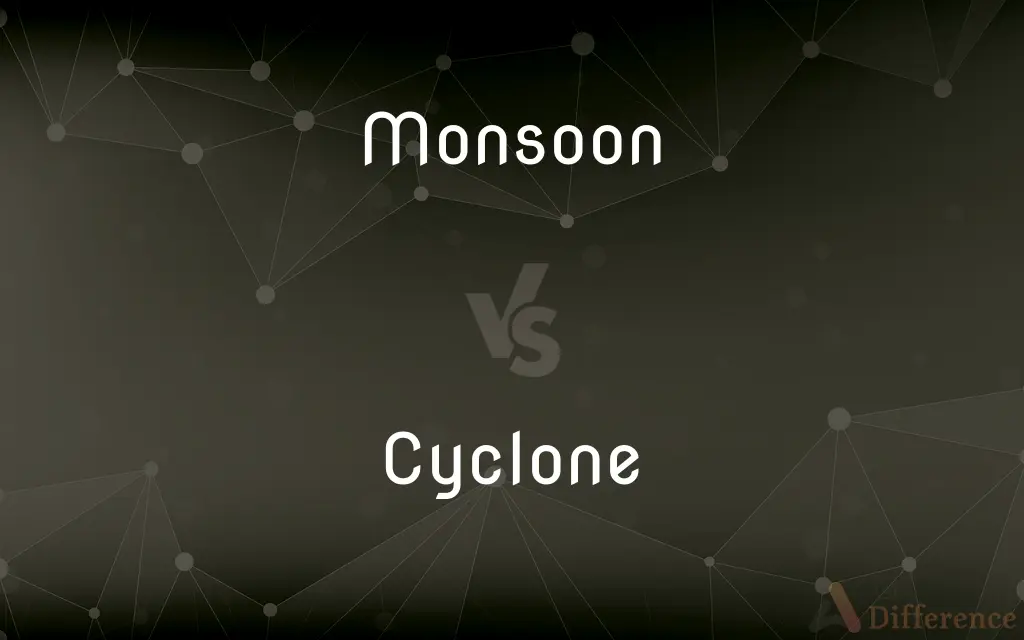Monsoon vs. Cyclone — What's the Difference?
By Urooj Arif & Fiza Rafique — Updated on April 2, 2024
Monsoons are seasonal wind patterns bringing prolonged rainfall, essential for agriculture in many regions, whereas cyclones are intense, destructive weather systems with high winds and heavy rains.

Difference Between Monsoon and Cyclone
Table of Contents
ADVERTISEMENT
Key Differences
Monsoons are characterized by their predictability and seasonal occurrence, shifting wind patterns that bring significant rainfall to certain regions, especially in South Asia and Africa. These rains are crucial for agriculture and water supply in these areas. On the other hand, cyclones are large-scale air mass circulation systems that form over warm ocean waters, typically characterized by low-pressure centers, high winds, and heavy rain. Unlike monsoons, cyclones can occur in various regions, including the Atlantic, Pacific, and Indian oceans, and are less predictable.
While monsoons can last for several months, providing much-needed precipitation for crops, cyclones are generally short-lived but can cause significant damage, including flooding, property damage, and loss of life. Monsoons are essential for the economies of many countries, supporting agriculture and replenishing water supplies, whereas cyclones often disrupt life and require extensive recovery efforts.
The formation of monsoons is driven by the temperature difference between the land and the ocean, leading to the reversal of wind direction in certain seasons. This results in predictable periods of heavy rainfall. In contrast, cyclones form over warm ocean waters when the conditions of high humidity, low wind shear, and warm sea surface temperatures combine, leading to the development of these powerful storms.
Monsoons impact large geographic areas, sometimes covering entire continents, and bring changes in weather patterns over months. Cyclones, while they can affect vast areas, typically have a more localized impact in terms of their direct destruction. The effects of cyclones, however, can extend beyond the immediate area of the storm through flooding, landslides, and disruptions to infrastructure and communication networks.
The terminology also differs; "monsoon" is derived from the Arabic word for season, reflecting its cyclical nature, whereas "cyclone" comes from the Greek word for coil of a snake, indicative of the storm’s swirling winds. This linguistic difference underscores the distinct nature of these two weather phenomena.
ADVERTISEMENT
Comparison Chart
Definition
Seasonal wind reversal bringing rain
Intense weather system with high winds
Duration
Lasts several months
Short-lived, usually days to weeks
Impact
Essential for agriculture
Causes damage, flooding, loss of life
Formation
Temperature difference land/ocean
Forms over warm ocean waters
Geographic Impact
Large areas, sometimes continents
More localized but can be widespread
Predictability
Seasonal and predictable
Less predictable, varies annually
Economic Effect
Generally beneficial for agriculture
Often disruptive and costly
Compare with Definitions
Monsoon
Affects large geographic regions.
The Asian monsoon impacts several countries.
Cyclone
Can lead to significant loss of life and property.
Cyclone Aidan left thousands homeless.
Monsoon
Can cause flooding but is generally beneficial.
The monsoon caused minor flooding but ensured a good harvest.
Cyclone
Associated with heavy rains and flooding.
The cyclone brought unprecedented rainfall to the region.
Monsoon
A seasonal wind pattern bringing rain.
The summer monsoon is vital for farming in India.
Cyclone
Requires emergency preparedness and response.
The government issued cyclone warnings and prepared evacuation plans.
Monsoon
Predictable and essential for agriculture.
Farmers plant their seeds before the monsoon starts.
Cyclone
An intense storm system with high winds.
The cyclone caused extensive damage to coastal areas.
Monsoon
Crucial for replenishing water sources.
The monsoon fills up the reservoirs each year.
Cyclone
Forms over warm ocean waters.
The cyclone developed quickly over the warm Pacific.
Monsoon
A monsoon () is traditionally a seasonal reversing wind accompanied by corresponding changes in precipitation, but is now used to describe seasonal changes in atmospheric circulation and precipitation associated with annual latitudinal oscillation of the Intertropical Convergence Zone between its limits to the north and south of the equator. Usually, the term monsoon is used to refer to the rainy phase of a seasonally changing pattern, although technically there is also a dry phase.
Cyclone
In meteorology, a cyclone () is a large scale air mass that rotates around a strong center of low atmospheric pressure, counterclockwise in the Northern Hemisphere and clockwise in the Southern Hemisphere as viewed from above (opposite to an anticyclone). Cyclones are characterized by inward-spiraling winds that rotate about a zone of low pressure.
Monsoon
A wind system that influences large climatic regions and reverses direction seasonally.
Cyclone
A system of winds rotating inwards to an area of low barometric pressure, with an anticlockwise (northern hemisphere) or clockwise (southern hemisphere) circulation; a depression.
Monsoon
A wind from the southwest or south that brings heavy rainfall to southern Asia in the summer.
Cyclone
An atmospheric system characterized by the rapid inward circulation of air masses about a low-pressure center, usually accompanied by stormy, often destructive weather. Cyclones circulate counterclockwise in the Northern Hemisphere and clockwise in the Southern Hemisphere.
Monsoon
A similar seasonal wind, as in the southwest United States, that brings increased rainfall.
Cyclone
A violent tropical storm, especially one originating in the southwestern Pacific Ocean or Indian Ocean.
Monsoon
The rain that comes with any of these winds or wind systems.
Cyclone
A violent rotating windstorm, especially a tornado.
Monsoon
Any of a number of winds associated with regions where most rain falls during a particular season.
Cyclone
Any of various devices using centrifugal force to separate materials.
Monsoon
Tropical rainy season when the rain lasts for several months with few interruptions.
Cyclone
(broad sense) A weather phenomenon consisting of a system of winds rotating around a center of low atmospheric pressure
Monsoon
The rains themselves.
Cyclone
(narrow sense) Such weather phenomenon occurring in the South Pacific and Indian Ocean
Monsoon
Entire meteorological systems with such characteristics.
Cyclone
A low pressure system.
Monsoon
A wind blowing part of the year from one direction, alternating with a wind from the opposite direction; - a term applied particularly to periodical winds of the Indian Ocean, which blow from the southwest from the latter part of May to the middle of September, and from the northeast from about the middle of October to the middle of December.
Cyclone
(informal) The more or less violent, small-scale circulations such as tornadoes, waterspouts, and dust devils.
Monsoon
A heavy rainfall in India associated with the southwest monsoon{1}.
Cyclone
A strong wind.
Monsoon
The season in which the monsoon{2} occurs.
Cyclone
A cyclone separator; the cylindrical vortex tube within such a separator
Monsoon
A seasonal wind in southern Asia; blows from the southwest (bringing rain) in summer and from the northeast in winter
Cyclone
To separate using a cyclone separator.
Monsoon
Rainy season in southern Asia when the southwestern monsoon blows, bringing heavy rains
Cyclone
To storm as a cyclone.
Monsoon
Any wind that changes direction with the seasons
Cyclone
To whirl in spirals as a result of a cyclone or whirlwind-like force.
Cyclone
To storm wildly; to be in a frenzy.
Cyclone
A violent storm, often of vast extent, characterized by high winds rotating about a calm center of low atmospheric pressure. This center moves onward, often with a velocity of twenty or thirty miles an hour.
Cyclone
In general, a condition of the atmosphere characterized by a central area of pressure much lower than that of surrounding areas, and a system of winds blowing inward and around (clockwise in the southern hemisphere and counter-clockwise in the northern); - called also a low-area storm. It is attended by high temperature, moist air, abundant precipitation, and clouded sky. The term includes the hurricane, typhoon, and tropical storms; it should not be applied to the moderate disturbances attending ordinary areas of low pressure nor to tornadoes, waterspouts, or "twisters," in which the vertical motion is more important than the horizontal.
Cyclone
A tornado. See above, and Tornado.
Cyclone
(meteorology) rapid inward circulation of air masses about a low-pressure center; circling counterclockwise in the northern hemisphere and clockwise in the southern
Cyclone
A violent rotating windstorm
Common Curiosities
Why are monsoons important?
Monsoons are important for providing the necessary rainfall for agriculture in many regions, replenishing water supplies.
How do monsoons affect people's lives?
Monsoons significantly impact agriculture, water supply, and overall climate, generally in a positive manner by providing essential rainfall.
What's the difference between a monsoon and a cyclone?
Monsoons are seasonal wind patterns that bring rain, crucial for agriculture, while cyclones are intense storms with high winds and heavy rains, causing damage.
Can a cyclone occur during a monsoon?
Yes, cyclones can occur during monsoon seasons, especially in tropical regions, adding to the rain and potential for flooding.
What causes a cyclone to form?
Cyclones form over warm ocean waters from a combination of high humidity, low wind shear, and warm sea surface temperatures.
What regions are most affected by cyclones?
Tropical regions, including parts of Southeast Asia, the Pacific, the Indian Ocean, and the Atlantic, are most affected by cyclones.
What is the role of climate change in monsoons and cyclones?
Climate change can intensify both monsoons and cyclones, affecting their patterns, intensity, and impacts.
What safety measures are important for cyclones?
Preparing emergency kits, following evacuation orders, and securing property are key safety measures for cyclones.
What is the difference in the scale of impact between monsoons and cyclones?
Monsoons affect larger areas and populations over months, while cyclones have a more localized but intense impact.
Are monsoons predictable?
Yes, monsoons are predictable and occur seasonally, unlike the less predictable cyclones.
How do monsoons impact the economy?
Monsoons positively impact the economy by supporting agriculture, which is a primary source of income in many regions.
Can technology predict cyclones accurately?
Advances in technology have improved cyclone prediction, but there remains uncertainty in their exact path and intensity.
How do communities prepare for monsoon season?
Communities prepare by strengthening infrastructure, planning water management, and ensuring adequate agricultural practices.
Why do some regions depend on monsoons?
Some regions depend on monsoons for their agricultural cycles, water supply, and overall climate.
How can people protect themselves from cyclones?
By adhering to early warning systems, evacuating if necessary, and securing homes against high winds and flooding.
Share Your Discovery

Previous Comparison
Carpentry vs. Masonry
Next Comparison
Arugula vs. RucolaAuthor Spotlight
Written by
Urooj ArifUrooj is a skilled content writer at Ask Difference, known for her exceptional ability to simplify complex topics into engaging and informative content. With a passion for research and a flair for clear, concise writing, she consistently delivers articles that resonate with our diverse audience.
Co-written by
Fiza RafiqueFiza Rafique is a skilled content writer at AskDifference.com, where she meticulously refines and enhances written pieces. Drawing from her vast editorial expertise, Fiza ensures clarity, accuracy, and precision in every article. Passionate about language, she continually seeks to elevate the quality of content for readers worldwide.















































